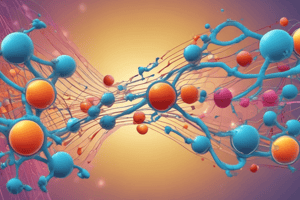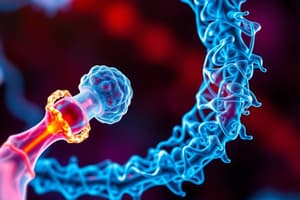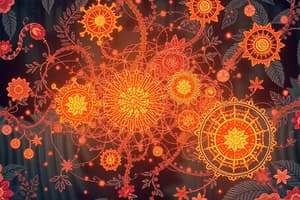Podcast
Questions and Answers
What is the primary purpose of pyruvate oxidation in cellular respiration?
What is the primary purpose of pyruvate oxidation in cellular respiration?
- To convert pyruvate into glucose
- To produce oxygen for the electron transport chain
- To prepare products of glycolysis for the citric acid cycle (correct)
- To generate ATP directly
Which of the following molecules is NOT a product of pyruvate oxidation?
Which of the following molecules is NOT a product of pyruvate oxidation?
- CO2
- ATP (correct)
- Acetyl-CoA
- NADH
How many molecules of NADH are produced during pyruvate oxidation for every two pyruvate molecules?
How many molecules of NADH are produced during pyruvate oxidation for every two pyruvate molecules?
- 3
- 1
- 4
- 2 (correct)
What is the total number of CO2 molecules generated from pyruvate oxidation of two pyruvate molecules?
What is the total number of CO2 molecules generated from pyruvate oxidation of two pyruvate molecules?
Which cycle also occurs in the mitochondrial matrix along with pyruvate oxidation?
Which cycle also occurs in the mitochondrial matrix along with pyruvate oxidation?
What role does Complex IV play in electron transport?
What role does Complex IV play in electron transport?
What happens in the presence of carbon monoxide and cyanide regarding Complex IV?
What happens in the presence of carbon monoxide and cyanide regarding Complex IV?
What is a consequence of oxygen not being able to accept electrons?
What is a consequence of oxygen not being able to accept electrons?
What is the primary purpose of NADH and FADH2 in cellular respiration?
What is the primary purpose of NADH and FADH2 in cellular respiration?
During anaerobic respiration, what occurs when oxygen is lacking?
During anaerobic respiration, what occurs when oxygen is lacking?
How do protons move across the membrane in relation to ATP synthase?
How do protons move across the membrane in relation to ATP synthase?
What is the effect of competitive inhibitors on Complex IV?
What is the effect of competitive inhibitors on Complex IV?
What is produced during the energy harvest phase of glycolysis?
What is produced during the energy harvest phase of glycolysis?
How many ATP are produced from one molecule of NADH?
How many ATP are produced from one molecule of NADH?
What is the total yield of ATP produced from glycolysis?
What is the total yield of ATP produced from glycolysis?
What is the yield of ATP for one molecule of FADH2?
What is the yield of ATP for one molecule of FADH2?
Which process produces the greatest number of NADH molecules?
Which process produces the greatest number of NADH molecules?
During which stage of cellular respiration is acetyl-CoA produced?
During which stage of cellular respiration is acetyl-CoA produced?
Which process is associated with the highest proton (H+) pumping?
Which process is associated with the highest proton (H+) pumping?
What is the total output of CO2 from the citric acid cycle?
What is the total output of CO2 from the citric acid cycle?
Which of the following outputs occurs during glycolysis?
Which of the following outputs occurs during glycolysis?
What does the term 'oxidized' refer to in the context of electron carriers?
What does the term 'oxidized' refer to in the context of electron carriers?
Which electron carrier is involved in photosynthesis?
Which electron carrier is involved in photosynthesis?
Which of the following is NOT a phase of cellular respiration?
Which of the following is NOT a phase of cellular respiration?
What process occurs in the cytoplasm of cells during cellular respiration?
What process occurs in the cytoplasm of cells during cellular respiration?
What is the main purpose of the four interconnected processes in cellular respiration?
What is the main purpose of the four interconnected processes in cellular respiration?
In which phase of cellular respiration is ATP primarily produced?
In which phase of cellular respiration is ATP primarily produced?
Which of the following best describes the concept of entropy in energy contexts?
Which of the following best describes the concept of entropy in energy contexts?
What occurs during the energy investment phase of glycolysis?
What occurs during the energy investment phase of glycolysis?
What is the main output of glycolysis?
What is the main output of glycolysis?
Which cycle produces the most NADH during cellular respiration?
Which cycle produces the most NADH during cellular respiration?
How many net ATP are generated from glycolysis?
How many net ATP are generated from glycolysis?
Where does the electron transport chain take place?
Where does the electron transport chain take place?
What is produced during pyruvate oxidation?
What is produced during pyruvate oxidation?
Which of the following is NOT an output of the citric acid cycle?
Which of the following is NOT an output of the citric acid cycle?
Total NADH produced from glycolysis and pyruvate oxidation combined?
Total NADH produced from glycolysis and pyruvate oxidation combined?
Which molecule enters the citric acid cycle?
Which molecule enters the citric acid cycle?
How many ATP are produced from the entire process of glycolysis?
How many ATP are produced from the entire process of glycolysis?
What are the byproducts of the citric acid cycle?
What are the byproducts of the citric acid cycle?
Flashcards are hidden until you start studying
Study Notes
Cellular Respiration
- Cellular Respiration generates ATP (adenosine triphosphate) from glucose as a source of energy.
- A simplified model of the complete respiration process includes:
- Glycolysis
- Pyruvate oxidation
- Citric Acid Cycle
- Electron transport chain
Glycolysis
-
Takes place in the cytoplasm.
-
It is an anaerobic process (does not require oxygen).
-
Glycolysis breaks down glucose (a 6-carbon molecule) into two pyruvate molecules (each with 3 carbons).
-
Input: Glucose, 2 ATP, 2 NAD+
-
Outputs: 2 pyruvate (3-C), 2 NADH, 2 ATP (net total)
Pyruvate Oxidation
-
Takes place in the mitochondrial matrix.
-
It is an anaerobic process (does not require oxygen).
-
Pyruvate is converted into Acetyl-CoA, carbon dioxide, and NADH.
-
Input: 2 Pyruvate, 2 NAD+, 2 CoA
-
Outputs: 2 acetyl-CoA, 2 NADH, 2 CO2
Citric Acid Cycle (Krebs Cycle)
-
Takes place in the mitochondrial matrix.
-
It is an aerobic process (requires oxygen).
-
Starts by Acetyl-CoA combining with a 4-carbon molecule, oxaloacetate.
-
Energy is harvested through series of redox reactions, releasing carbon dioxide and generating ATP, NADH, and FADH2.
-
Input: 2 Acetyl-CoA, 6 NAD+, 2 FAD, 2 ADP + 2 Pi
-
Outputs: 4 CO2, 6 NADH, 2 FADH2, 2 ATP
Electron Transport Chain
-
Takes place in the inner membrane of the mitochondria (specifically the cristae).
-
It is an aerobic process (requires oxygen).
-
Electron carriers (NADH and FADH2) from the previous stages transfer electrons through a series of protein complexes embedded in the inner membrane.
-
Energy is released as the electrons move down the chain, pumping protons (H+) from the mitochondrial matrix into the intermembrane space.
-
This creates a proton gradient across the membrane.
-
This gradient is used by ATP synthase to phosphorylate ADP to ATP via oxidative phosphorylation, a key process for generating ATP.
-
Input: 10 NADH, 2 FADH2, oxygen
-
Outputs: ATP, Water
ATP Production
-
Glycolysis: 2 ATP (net total)
-
Citric Acid Cycle: 2 ATP
-
Electron Transport Chain: 28 ATP (from 10 NADH and 2 FADH2)
-
Total ATP yield: 32 ATP
Anaerobic Respiration and Fermentation
- Anaerobic respiration and fermentation occur when oxygen is not available.
- Glycolysis can continue under anaerobic conditions.
- Fermentation is a process that allows cells to regenerate NAD+ by reducing pyruvate into lactic acid or ethanol.
Role of Electron Carriers
- NADH and FADH2 are electron carriers that transfer electrons during respiration.
- Electron carriers shuttle electrons released from chemical bonds in glucose.
- They cycle through the electron transport chain, releasing energy that drives ATP synthesis.
- Other electron carriers include:
- NADP+ (in chloroplasts during photosynthesis)
- FAD (in cellular respiration)
Carbon Monoxide and Cyanide Inhibition
- Carbon monoxide and cyanide are inhibitors of the electron transport chain.
- They bind to complex IV, preventing the passage of electrons and halting ATP production.
- This disrupts the oxygen-dependent steps of cellular respiration.
Entropy and Energy Maximization
- Chemical reactions tend to move toward increased entropy (disorganization) and less potential energy.
- Cellular respiration is a series of exergonic reactions that convert glucose into less organized products (water, CO2) while releasing free energy for ATP synthesis.
- Four interconnected processes maximize energy production:
- Glycolysis
- Pyruvate Oxidation
- Citric Acid Cycle
- Electron Transport Chain
- The multiple steps ensure a gradual release of energy, minimizing heat loss and maximizing ATP production.
Studying That Suits You
Use AI to generate personalized quizzes and flashcards to suit your learning preferences.




